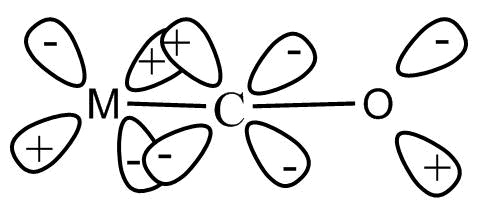
Due to the back bonding in metal carbonyls:
(A) Strength of metal-carbon bond decreases
(B) Strength of carbon-oxygen bond increases
(C) Strength of all bonds is unaffected
(D) Strength of carbon-oxygen bond decreases
Answer
563.1k+ views
Hint: Back bounding is a type of bonding that occurs between atoms in a compound in which one atom has a lone pair of electrons and the other has a vacant orbital placed adjacent to each other.
Complete step by step answer:
Synergic bonding interactions are present in metal carbonyls. The sigma bond is formed when a lone pair of electrons of carbonyl carbon is donated to a vacant orbital of metal. To form a pi bond, an electron pair is donated from filled metal d-orbital to vacant anti-bonding pi-orbitals of $CO$. This involves lateral overlap of orbitals. Due to this the electron density in the bonding pi-orbitals of $CO$ decreases and anti-bonding pi-orbitals increases. This decreases the bond order. Hence, the strength of carbon oxygen bond decreases. The strength of metal carbon bonds increases.
So, the correct answer is Option D .
Additional information:
A compound with back bonding has pi-bonding character since it results after formation of sigma bond.
Back bonding allows the molecule to stabilize as it completes its octet. Back bonding results in decrease in bond length and increase in bond order.

Note: Condition for back bonding is that both the atoms bonded in back bonding must be present in $2nd - 2nd$ or $2nd - 3rd$ period. One of the atoms has lone pairs and another has vacant orbital and direction of back bonding depends upon vacant orbital. The vacant orbital must have a localized donatable electron pair.
Complete step by step answer:
Synergic bonding interactions are present in metal carbonyls. The sigma bond is formed when a lone pair of electrons of carbonyl carbon is donated to a vacant orbital of metal. To form a pi bond, an electron pair is donated from filled metal d-orbital to vacant anti-bonding pi-orbitals of $CO$. This involves lateral overlap of orbitals. Due to this the electron density in the bonding pi-orbitals of $CO$ decreases and anti-bonding pi-orbitals increases. This decreases the bond order. Hence, the strength of carbon oxygen bond decreases. The strength of metal carbon bonds increases.
So, the correct answer is Option D .
Additional information:
A compound with back bonding has pi-bonding character since it results after formation of sigma bond.
Back bonding allows the molecule to stabilize as it completes its octet. Back bonding results in decrease in bond length and increase in bond order.

Note: Condition for back bonding is that both the atoms bonded in back bonding must be present in $2nd - 2nd$ or $2nd - 3rd$ period. One of the atoms has lone pairs and another has vacant orbital and direction of back bonding depends upon vacant orbital. The vacant orbital must have a localized donatable electron pair.
Recently Updated Pages
The number of solutions in x in 02pi for which sqrt class 12 maths CBSE

Write any two methods of preparation of phenol Give class 12 chemistry CBSE

Differentiate between action potential and resting class 12 biology CBSE

Two plane mirrors arranged at right angles to each class 12 physics CBSE

Which of the following molecules is are chiral A I class 12 chemistry CBSE

Name different types of neurons and give one function class 12 biology CBSE

Trending doubts
One Metric ton is equal to kg A 10000 B 1000 C 100 class 11 physics CBSE

What is 1s 2s 2p 3s 3p class 11 chemistry CBSE

Discuss the various forms of bacteria class 11 biology CBSE

State the laws of reflection of light

Explain zero factorial class 11 maths CBSE

An example of chemosynthetic bacteria is A E coli B class 11 biology CBSE




